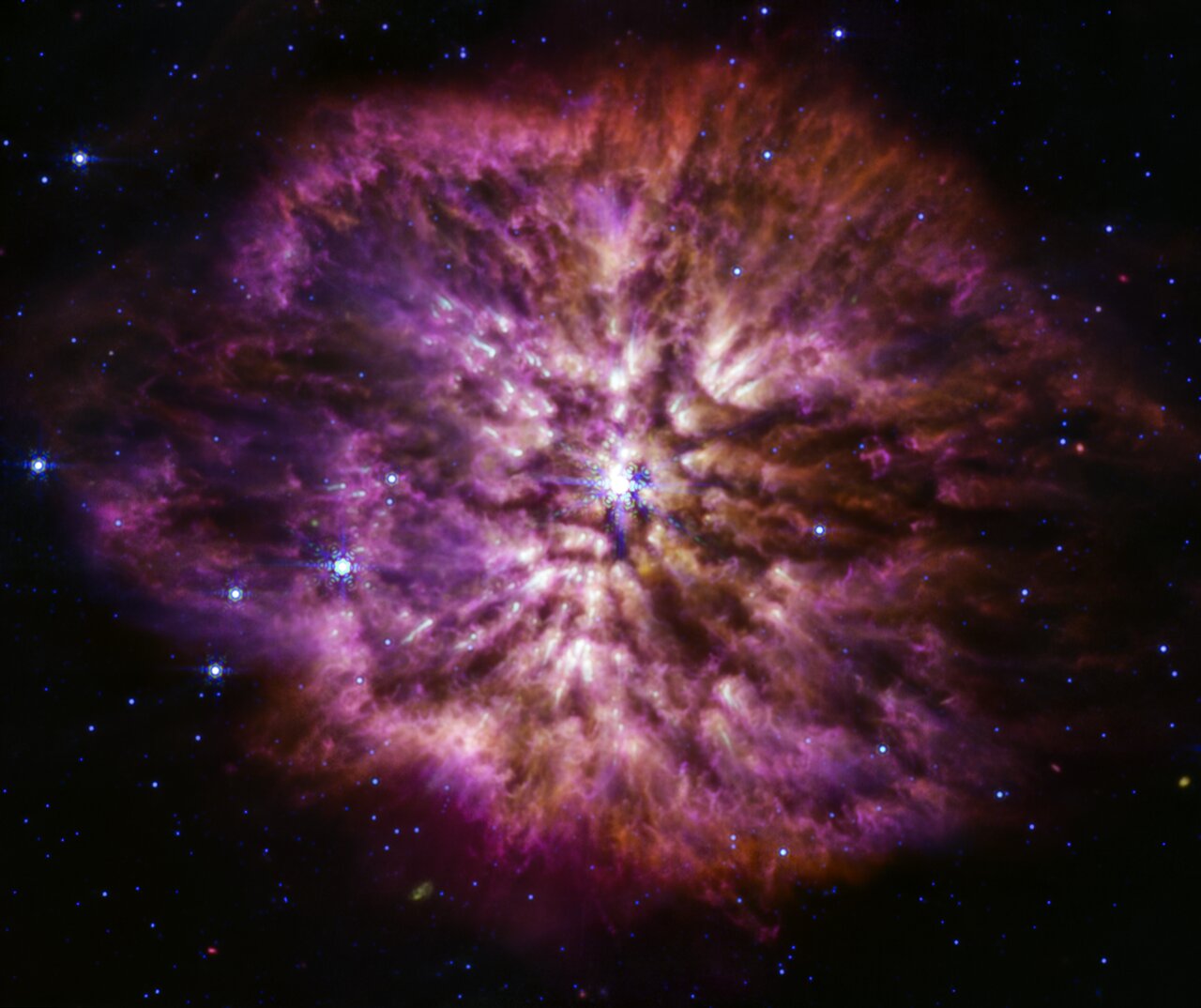James Webb Space Telescope Discovery
Clicking on each image will open the full resolution one. Try it!Clicking on "Raw images" image will yield all the relevant raw images.
Wolf-Rayet 124
The luminous, hot star Wolf-Rayet 124 (WR 124) is prominent at the centre of the NASA/ESA/CSA James Webb Space Telescope’s composite image combining near-infrared and mid-infrared wavelengths of light. The star displays the characteristic diffraction spikes of Webb’s Near-infrared Camera (NIRCam), caused by the physical structure of the telescope itself. NIRCam effectively balances the brightness of the star with the fainter gas and dust surrounding it, while Webb’s Mid-Infrared Instrument (MIRI) reveals the nebula’s structure.
Background stars and galaxies populate the field of view and peek through the nebula of gas and dust that has been ejected from the ageing massive star to span 10 light-years across space. A history of the star’s past episodes of mass loss can be read in the nebula’s structure. Rather than smooth shells, the nebula is formed from random, asymmetric ejections. Bright clumps of gas and dust appear like tadpoles swimming toward the star, their tails streaming out behind them, blown back by the stellar wind.
This image combines various filters from both Webb imaging instruments, with the colour red assigned to wavelengths of 4.44, 4.7, 12.8, and 18 microns (F444W, F470N, F1280W, F1800W), green to 2.1, 3.35, and 11.3 microns (F210M, F335M, F1130W), and blue to 0.9, 1.5, and 7.7 microns (F090W, F150W, F770W).
Credit: NASA, ESA, CSA, STScI, Webb ERO Production Team
 Wolf-Rayet 124 (NIRCam and MIRI composite image)
Wolf-Rayet 124 (NIRCam and MIRI composite image)
 Wolf-Rayet 124 (NIRCam and MIRI composite image - annotated)
Wolf-Rayet 124 (NIRCam and MIRI composite image - annotated)
 Wolf-Rayet 124 (MIRI image) - Full image, low res
Wolf-Rayet 124 (MIRI image) - Full image, low res
 Wolf-Rayet 124 (MIRI image) - Partial image, full res
Wolf-Rayet stars are known to be efficient dust producers, and the Mid-Infrared Instrument (MIRI) on the NASA/ESA/CSA James Webb Space Telescope shows this to great effect. Cooler cosmic dust glows at the longer mid-infrared wavelengths, displaying the structure of WR 124’s nebula. The 10 light-years-wide nebula is made of material cast off from the ageing star in random ejections, and from dust produced in the ensuing turbulence. This brilliant stage of mass loss precedes the star’s eventual supernova, when nuclear fusion in its core stops and the pressure of gravity causes it to collapse in on itself, and then explode. As MIRI demonstrates here, Webb will help astronomers to explore questions that were previously only available to theory, questions like how much dust stars like this create before exploding in a supernova, and how much of that dust is large enough to survive the blast and go on to serve as a building block of future stars and planets.
Wolf-Rayet 124 (MIRI image) - Partial image, full res
Wolf-Rayet stars are known to be efficient dust producers, and the Mid-Infrared Instrument (MIRI) on the NASA/ESA/CSA James Webb Space Telescope shows this to great effect. Cooler cosmic dust glows at the longer mid-infrared wavelengths, displaying the structure of WR 124’s nebula. The 10 light-years-wide nebula is made of material cast off from the ageing star in random ejections, and from dust produced in the ensuing turbulence. This brilliant stage of mass loss precedes the star’s eventual supernova, when nuclear fusion in its core stops and the pressure of gravity causes it to collapse in on itself, and then explode. As MIRI demonstrates here, Webb will help astronomers to explore questions that were previously only available to theory, questions like how much dust stars like this create before exploding in a supernova, and how much of that dust is large enough to survive the blast and go on to serve as a building block of future stars and planets.
 Hubble’s view of Wolf-Rayet 124
Hubble’s view of Wolf-Rayet 124
 Raw images
Raw images